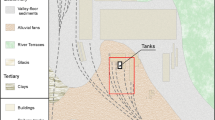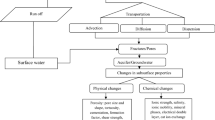Abstract
Underground contamination by non-aqueous phase liquids (NAPLs) becomes increasingly serious. Rapid and reliable detection of contaminated zone and degree is the first step to site remediation. In this paper, diesel and fine sand are used as experiment materials to investigate the applicability of using time-domain reflectometry (TDR) to detect LNAPLs contamination. The major work includes: measurement of dielectric constant and electrical conductivity for the diesel-water-air-sand mixtures; measurement of reflection waveform and dielectric constant for specimens with a diesel contaminated layer being sandwiched in sand. The experimental results show the followings: A significant decrease in both dielectric constant and electrical conductivity is observed for the diesel-water-air-sand mixtures when diesel displaces the pore water, and the content of diesel can be calculated by the α model; insignificant change in dielectric properties is measured when diesel only displaces the pore gas; when the diesel contaminated sand is sandwiched between two saturated sand layers, the interfaces of the diesel contaminated layer can be identified by analyzing the reflection waveform; for field application, TDR method is valid for the case that LNAPLs seep into saturated sand layer, and the applicability of TDR method in vadose zone depends on the initial saturation of the sand layer. The findings obtained in this paper provide a guidance for the use of TDR for the field investigation of NAPLs contaminated site.
Similar content being viewed by others
References
Haridy S A, Persson M, Berndtsson R. Estimation of LNAPL saturation in fine sand using time-domain reflectometry. Hydrolog Sci J, 2004, 49(6): 987–1000
Chen R P, Xu W, Tang L J, et al. Development and application of TDR probes to monitor water level and electrical conductivity. Chin J Geotech Eng, 2009, 31(1): 77–82
Chen W. The Design of TDR Probe and Monitoring Technology of Water Content and Dry Density. Dissertation of Masteral Degree. Hangzhou: Zhejiang University, 2011. 49–54
Brewster M L, Redman J, Annan A. Monitoring a controlled injection of perchlorethylene in a sandy aquifer with ground penetrating radar and time domain reflectometry. App Geo Env Prob, 1992, 2: 611–618
Redman J D, Deryck S M. Monitoring non-aqueous phase liquids in the subsurface with multilevel time domain reflectometry probes. In: Jones C C, Dowding C H, O’connor K M, eds. Symposium and Workshop on Time Domain Reflectometry in Environmental, Infrastructure, and Mining Applications. Northwestern University: The Bureau, 1994. 207–214
Quafisheh N M. The Use of Time Domain Reflectometry (TDR) to Determine and Monitor Non-aqueous Phase (NAPLS) in Soils. Dissertation of Masteral Degree. Ohio: College of Engineering and Technology of Ohio University, 1997. 35–74
Ajo-Franklin J B, Geller J T, Harris J M. The dielectric properties of granular media saturated with DNAPL/water mixtures. Geophys Res Lett, 2004, 31(17): L17501
Ochawa A, Kumor M. Time domain reflectometry (TDR)-measuring dielectric constant of polluted soil to estimate diesel oil content. Arch Hydro-Eng Environ Mech, 2008, 55(1–2): 55–62
Persson M, Berndtsson R. Measuring nonaqueous phase liquid saturation in soil using time domain reflectometry. Water Resour Res, 2002, 38(5): 22-1–22-8
Francisca F M, Montoro M A. Measuring the dielectric properties of soil-organic mixtures using coaxial impedence dielectric reflectometry. J Appl Geophys, 2012, 80: 101–109
Topp G C, Davis J L, Annan A P. Electromagnetic determination of soil water content: Measurements in coaxial transmission lines. Water Resor Res, 1980, 16(3): 574–582
Fellner-Feldegg H. Measurement of dielectrics in the time domain. J Phys Chem, 1969, 73: 616–623
Topp G C, Yanuka M, Zebchuk W D, et al. Determination of electrical conductivity using time domain reflectometry: Soil and water experiments in coaxial lines. Water Resour Res, 1988, 24(7): 945–952
Dalton F N, Herkelrath W N, Rawlins D S, et al. Time domain reflectometry: Simultaneous measurement of soil water content and electrical conductivity with a single probe. Science, 1984, 224(4652): 989–990
Nadler A, Dasberg S, Lapid I. Time domain reflectometry measurements of water content and electrical conductivity of layered soil columns. Soil Sci Soc Am J, 1991, 55(4): 938–943
Giese K, Tiemann R. Determination of the complex permittivity from thin-sample time domain reflectometry improved analysis of the step response waveform. Adv Mol Relax Proc, 1975, 7(1): 45–49
Ferre P A, Knight J H, Rudolph D L, et al. The sample areas of conventional and alternative time domain reflectometry probes. Water Resour Res, 1998, 34(11): 2971–2979
Knight J H, Ferre P A, Rudolph D L, et al. A numerical analysis of the effects of coatings and gaps upon relative dielectric permittivity measurement with time domain reflectometry. Water Resour Res, 1997, 33(6): 1445–1460
Weast R C. Handbook of Physics and Chemistry, 1986
Kalinski R J, Kelly W E. Estimating water content of soils from electrical resistivety. ASTM Geotech Test J, 1993, 16(3): 323–329
Baker J M, Allmaras R R. System for automating and multiplexing soil moisture measurement by time-domain reflectometry. Soil Sci Soc Am J, 1990, 55(1): 1–6
Dirksen C, Dasberg S. Improved calibration of time domain reflectometry soil water content measurements. Soil Sci Soc Am J, 1993, 57(3): 660–667
Birchak J E, Gardner C G, Hipp J E, et al. High dielectric constant microwave probes for sensing soil moisture. Proc IEEE, 1974, 62(1): 93–98
Moroizumi T, Sasaki Y. Estimating the nonaqueous-phase liquid content in saturated sandy soil using amplitude domain reflectometry. Soil Sci Soc Am J, 2006, 72(6): 1520–1526
Author information
Authors and Affiliations
Corresponding author
Rights and permissions
About this article
Cite this article
Zhan, L., Mu, Q., Chen, Y. et al. Experimental study on applicability of using time-domain reflectometry to detect NAPLs contaminated sands. Sci. China Technol. Sci. 56, 1534–1543 (2013). https://doi.org/10.1007/s11431-013-5211-8
Received:
Accepted:
Published:
Issue Date:
DOI: https://doi.org/10.1007/s11431-013-5211-8




